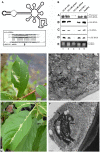Cytopathic Effects Incited by Viroid RNAs and Putative Underlying Mechanisms
- PMID: 23308076
- PMCID: PMC3538276
- DOI: 10.3389/fpls.2012.00288
Cytopathic Effects Incited by Viroid RNAs and Putative Underlying Mechanisms
Abstract
Viroids are infectious agents identified only in plants so far. In contrast to viruses, the genome of viroids is composed of a tiny circular RNA (250-400 nt) not coding for proteins, but containing in its compact structure all the information needed for parasitizing the transcriptional and RNA trafficking machineries of their hosts. Viroid infections are frequently accompanied by cellular and developmental disorders that ultimately result in macroscopic symptoms. The molecular events linking the structural domains of viroid RNAs with cellular and macroscopic alterations remain largely unexplored, although significant progress has been lately achieved in one specific viroid-host combination, highlighting the ability of viroids to strongly interfere with their host RNA regulatory networks. Cytopathic effects induced by nuclear-replicating viroids, which were investigated since early studies on viroids, consist in irregular proliferations of cell membranes (paramural bodies or plasmalemmasomes), cell wall distortions, and chloroplast malformations. Different alternatives have been proposed regarding how these cytological alterations may influence the onset of macroscopic symptoms. Recently, the cytopathology and histopathology incited by a chloroplast-replicating viroid have been investigated in depth, with defects in chloroplast development having been related to specific molecular events that involve RNA silencing and impairment of chloroplast ribosomal RNA maturation. On this basis, a tentative model connecting specific cytopathologic alterations with symptoms has been put forward. Here, early and more recent studies addressing this issue will be reviewed and reassessed in the light of recent advances in the regulatory roles of small RNAs.
Keywords: RNA silencing; cell wall; chloroplast; non-coding RNAs; pathogenesis; plasmalemmasome.
Figures


Similar articles
-
Viroids: how to infect a host and cause disease without encoding proteins.Biochimie. 2012 Jul;94(7):1474-80. doi: 10.1016/j.biochi.2012.02.020. Epub 2012 Feb 23. Biochimie. 2012. PMID: 22738729 Review.
-
Viroid pathogenesis: a critical appraisal of the role of RNA silencing in triggering the initial molecular lesion.FEMS Microbiol Rev. 2020 May 1;44(3):386-398. doi: 10.1093/femsre/fuaa011. FEMS Microbiol Rev. 2020. PMID: 32379313 Review.
-
Small RNAs containing the pathogenic determinant of a chloroplast-replicating viroid guide the degradation of a host mRNA as predicted by RNA silencing.Plant J. 2012 Jun;70(6):991-1003. doi: 10.1111/j.1365-313X.2012.04940.x. Epub 2012 Apr 4. Plant J. 2012. PMID: 22332758
-
Reassessment of Viroid RNA Cytosine Methylation Status at the Single Nucleotide Level.Viruses. 2019 Apr 18;11(4):357. doi: 10.3390/v11040357. Viruses. 2019. PMID: 31003406 Free PMC article.
-
Current overview on viroid-host interactions.Wiley Interdiscip Rev RNA. 2020 Mar;11(2):e1570. doi: 10.1002/wrna.1570. Epub 2019 Oct 22. Wiley Interdiscip Rev RNA. 2020. PMID: 31642206 Review.
Cited by
-
An Inside Look into Biological Miniatures: Molecular Mechanisms of Viroids.Int J Mol Sci. 2021 Mar 10;22(6):2795. doi: 10.3390/ijms22062795. Int J Mol Sci. 2021. PMID: 33801996 Free PMC article. Review.
-
Root Transcriptomic Analysis Reveals Global Changes Induced by Systemic Infection of Solanum lycopersicum with Mild and Severe Variants of Potato Spindle Tuber Viroid.Viruses. 2019 Oct 29;11(11):992. doi: 10.3390/v11110992. Viruses. 2019. PMID: 31671783 Free PMC article.
-
Understanding Citrus Viroid Interactions: Experience and Prospects.Viruses. 2024 Apr 9;16(4):577. doi: 10.3390/v16040577. Viruses. 2024. PMID: 38675919 Free PMC article. Review.
-
e-Book on plant virus infection-a cell biology perspective.Front Plant Sci. 2013 Jun 17;4:203. doi: 10.3389/fpls.2013.00203. eCollection 2013. Front Plant Sci. 2013. PMID: 23785382 Free PMC article. No abstract available.
-
Time-Course Microarray Analysis Reveals Differences between Transcriptional Changes in Tomato Leaves Triggered by Mild and Severe Variants of Potato Spindle Tuber Viroid.Viruses. 2018 May 15;10(5):257. doi: 10.3390/v10050257. Viruses. 2018. PMID: 29762480 Free PMC article.
References
-
- Conejero V., Belles J. M., Garcia-Breijo F., Garro R., Hernandez-Yago J., Rodrigo I., et al. (1990). “Signalling in viroid pathogenesis,” in Recognition and Response in Plant-Virus Interactions, NATO ASI Series H 41, ed. Fraser R. S. S. (Springer-Verlag: Berlin: ), 233–261
-
- Da Graça J. V., Martin M. M. (1981). Ultrastructural changes in avocado leaf tissue infected with avocado sunblotch. J. Phytopathol. 102, 195–19410.1111/j.1439-0434.1981.tb03380.x - DOI
LinkOut - more resources
Full Text Sources
Other Literature Sources
Research Materials

